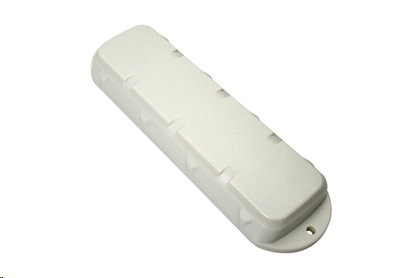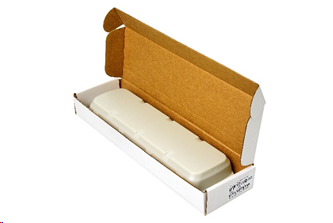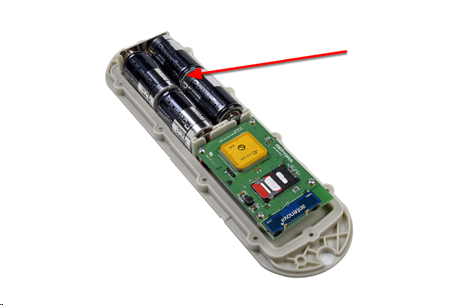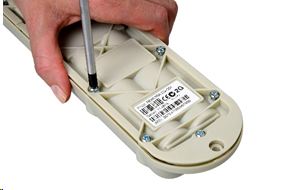Remora3G - Getting Started
Table of Contents
The Remora is a low-profile, rugged 2G or 3G (NextG) GPS tracking device that has been designed for tracking containers, trailers, skip bins, and other assets where super long battery life is required without sacrificing the frequency of updates and performance.\

In The Box
You'll get a compact box containing the Remora. The 10 housing screws will be in a small packet inside the housing.

Setting it Up
SIM Card
The SIM holder is on the top of the main board, between the two antennas. When handling the Remora be careful not to touch the GPS antenna, to minimise the risk of damaging the sensitive GPS amplifiers with static discharge.
- Unlock the sim holder by sliding the metal bracket towards the hinge.
- The SIM should be inserted with the keyed corner on the non-hinged side, and the SIM. contacts orientated down to the main board.
- Press the SIM down, and relock the holder by sliding the metal bracket away from the hinge.
To easily get up and running:
- The SIM should not have a PIN on it, unless you use the device specific PIN.
- The SIM should have credit or airtime
- The SIM should use one of the APN's built into the firmware. Otherwise contact Digital Matter support about APN setup. It is possible to set APN's by SMS, for more information view the APN section on the knowledge base.
Batteries
The Remora uses 4 x C-Cell batteries. Take care to insert the batteries with the correct polarity. The springs are the negative terminals. Once inserted, the LED next to the GPS antenna should flash briefly. If it does not, it means the unit has not yet reset. In this case, remove the batteries for a minute or two to allow any residual charge to drain, and then reinsert them. Failure to reset the unit will prevent automatic APN detection, and proper resetting of the battery life statistics

The quality of the C-Cell batteries used has a significant impact on the reliability of the product. A single cell failure can render the device useless. Use good quality industrial C-Cells for maximum reliability. It is important to acknowledge the failure rate of the batteries – a 1% chance of a premature failure per cell equates to a 4% chance for the Remora. Alkaline batteries commonly have a 1% premature failure rate.
The following alkaline batteries are recommended:
Panasonic LR14XW Industrial type
For extreme temperatures and high capacity, use Lithium-Thionyl-Chloride batteries. These cells are significantly more expensive and harder to dispose.
Recommended LTC cells: SAFT LSH14
Housing
- Seal the device carefully to achieve the IP67 rating. Ensure that the clear silicon seal is in good condition, is lying flat, and is not fouled by any plastic swarf or by protruding connector cables.
- Place the lid on the base, and gently squeeze it shut. Foam in the lid will compress against the batteries, holding them firmly in place when the unit is turned over.
- Warning: Be sure to place the lid the correct way around. The foam should be over the batteries. Screwing the lid down the wrong way will damage the base.
- Tighten the 10 screws to a uniform tightness. On the first assembly the screws may be quite stiff. An electric screwdriver with a torque limiting clutch is recommended.
- The screws used are a thermoplastic screw: 3.5mm x 12mm (BN82428).
If you wish to replace the batteries and open the housing, be sure to check that the silicon seal is in good condition before closing the housing again.

Device installation
The Remora can be mounted on the asset to be tracked using screws, bolts, cable ties, or industrial adhesives. When choosing a mounting point, you have two competing goals:
- To minimise the chances of the device being accidentally crushed or dislodged.
- To maximise the GPS and mobile reception, and provide adequate ventilation.
Since the Remora is a battery powered device, reception is critical to its performance. While other members of the DM product family rely on their high quality GPS receivers for enhanced accuracy and the ability to operate in very low signal, the primary concern for the Remora is the battery used during each GPS fix.
When Alkaline batteries are being used, it is important to choose a mounting point that will not result in elevated temperatures. For instance, mounting the Remora in direct sunlight on the dash of an unventilated cabin may cook the batteries, leading to abnormally short service life.
If your Remora is fitted with the magnetic tamper detection option, ensure that the magnet firmly adheres to the surface of the mount point, and aligns with the circular recess on the underside of the Remora. If it is not stuck strongly to the mount point, either magnetically or with the aid of adhesives, it may instead stick to the Remora. Ensure that it will reliably separate from the Remora during tampering, so that the alarm will be triggered.
Getting Online
Once the batteries are inserted, the internal LED will come on and flash. If the SIM card works, the device will connect to the OEM Server. You can go to www.oemserver.com/installer and search for the serial number to confirm that it has connected recently.
The LED will flash slowly at first. When it opens a connection to the server, it will flash fast. Once data is sent, it will go solid briefly, and revert to flashing fast. When the device goes to sleep, the LED will switch off.
If the LED flashes but the Remora does not connect, check the SIM is in the holder correctly and check that the SIM is working.
Default Settings
By default, the Remora is setup for trip tracking. The following default settings apply:
| Out of Trip: | 12 hour heartbeats. This is a GPS point and an upload every 12 hours. |
| In Trip: | In Trip: |
| Upload on trip start & end. | Yes |
| In Trip Logging Period | 120 seconds |
| In Trip Upload | 30 minutes/1800 seconds |
| Trip End | 5 minutes of no movement detected |
These settings and many more are configurable in the OEM Admin Interface. The defaults provide a good starting point. It is important to monitor and tweak your settings to ensure the battery life is acceptable. Incorrect settings can flatten the batteries quickly. Contact Support for help with this.
Tamper Detect
The Remora can wirelessly detect tampering. An optional HES board can be installed inside the Remora to report on the presence of a magnetic field. If used, the Remora should be installed over a magnet. The magnet fits into a recess underneath the Remora housing. The magnet should be glued securely to the asset. The Remora will then log a tamper and upload if the magnetic field is lost. The tamper status is put into Digital Input 1 in the uploaded information.
HES boards are optional and should be specified when ordering. If an HES board is installed, a magnet of the correct size will be provided with the Remora.
